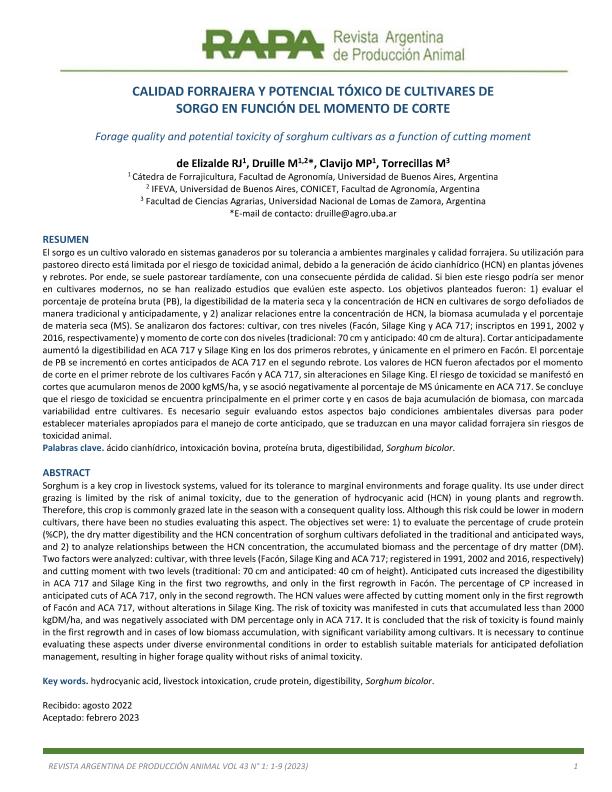Artículo
El sorgo es un cultivo valorado en sistemas ganaderos por su tolerancia a ambientes marginales y calidad forrajera. Su utilización para pastoreo directo está limitada por el riesgo de toxicidad animal, debido a la generación de ácido cianhídrico (HCN) en plantas jóvenes y rebrotes. Por ende, se suele pastorear tardíamente, con una consecuente pérdida de calidad. Si bien este riesgo podría ser menor en cultivares modernos, no se han realizado estudios que evalúen este aspecto. Los objetivos planteados fueron: 1) evaluar el porcentaje de proteína bruta (PB), la digestibilidad de la materia seca y la concentración de HCN en cultivares de sorgo defoliados de manera tradicional y anticipadamente, y 2) analizar relaciones entre la concentración de HCN, la biomasa acumulada y el porcentaje de materia seca (MS). Se analizaron dos factores: cultivar, con tres niveles (Facón, Silage King y ACA 717; inscriptos en 1991, 2002 y 2016, respectivamente) y momento de corte con dos niveles (tradicional: 70 cm y anticipado: 40 cm de altura). Cortar anticipadamente aumentó la digestibilidad en ACA 717 y Silage King en los dos primeros rebrotes, y únicamente en el primero en Facón. El porcentaje de PB se incrementó en cortes anticipados de ACA 717 en el segundo rebrote. Los valores de HCN fueron afectados por el momento de corte en el primer rebrote de los cultivares Facón y ACA 717, sin alteraciones en Silage King. El riesgo de toxicidad se manifestó en cortes que acumularon menos de 2000 kgMS/ha, y se asoció negativamente al porcentaje de MS únicamente en ACA 717. Se concluye que el riesgo de toxicidad se encuentra principalmente en el primer corte y en casos de baja acumulación de biomasa, con marcada variabilidad entre cultivares. Es necesario seguir evaluando estos aspectos bajo condiciones ambientales diversas para poder establecer materiales apropiados para el manejo de corte anticipado, que se traduzcan en una mayor calidad forrajera sin riesgos de toxicidad animal. Sorghum is a key crop in livestock systems, valued for its tolerance to marginal environments and forage quality. Its use under direct grazing is limited by the risk of animal toxicity, due to the generation of hydrocyanic acid (HCN) in young plants and regrowth. Therefore, this crop is commonly grazed late in the season with a consequent quality loss. Although this risk could be lower in modern cultivars, there have been no studies evaluating this aspect. The objectives set were: 1) to evaluate the percentage of crude protein (%CP), the dry matter digestibility and the HCN concentration of sorghum cultivars defoliated in the traditional and anticipated ways, and 2) to analyze relationships between the HCN concentration, the accumulated biomass and the percentage of dry matter (DM). Two factors were analyzed: cultivar, with three levels (Facón, Silage King and ACA 717; registered in 1991, 2002 and 2016, respectively) and cutting moment with two levels (traditional: 70 cm and anticipated: 40 cm of height). Anticipated cuts increased the digestibility in ACA 717 and Silage King in the first two regrowths, and only in the first regrowth in Facón. The percentage of CP increased in anticipated cuts of ACA 717, only in the second regrowth. The HCN values were affected by cutting moment only in the first regrowth of Facón and ACA 717, without alterations in Silage King. The risk of toxicity was manifested in cuts that accumulated less than 2000 kgDM/ha, and was negatively associated with DM percentage only in ACA 717. It is concluded that the risk of toxicity is found mainly in the first regrowth and in cases of low biomass accumulation, with significant variability among cultivars. It is necessary to continue evaluating these aspects under diverse environmental conditions in order to establish suitable materials for anticipated defoliation management, resulting in higher forage quality without risks of animal toxicity.
Calidad forrajera y potencial tóxico de tres cultivares de sorgo en función del momento de corte
Título:
Forage quality and potential toxicity of sorghum cultivars as a function of cutting moment
Fecha de publicación:
11/2023
Editorial:
Asociación Argentina de Producción Animal
Revista:
Revista Argentina de Producción Animal
ISSN:
0326-0550
Idioma:
Español
Tipo de recurso:
Artículo publicado
Clasificación temática:
Resumen
Archivos asociados
Licencia
Identificadores
Colecciones
Articulos(IFEVA)
Articulos de INST.D/INV.FISIOLOGICAS Y ECO.VINCULADAS A L/AGRIC
Articulos de INST.D/INV.FISIOLOGICAS Y ECO.VINCULADAS A L/AGRIC
Citación
de Elizalde, Rufino J.; Druille, Magdalena; Clavijo, Maria del Pilar; Torrecillas, Marcelo Gustavo; Calidad forrajera y potencial tóxico de tres cultivares de sorgo en función del momento de corte; Asociación Argentina de Producción Animal; Revista Argentina de Producción Animal; 43; 1; 11-2023; 1-9
Compartir




